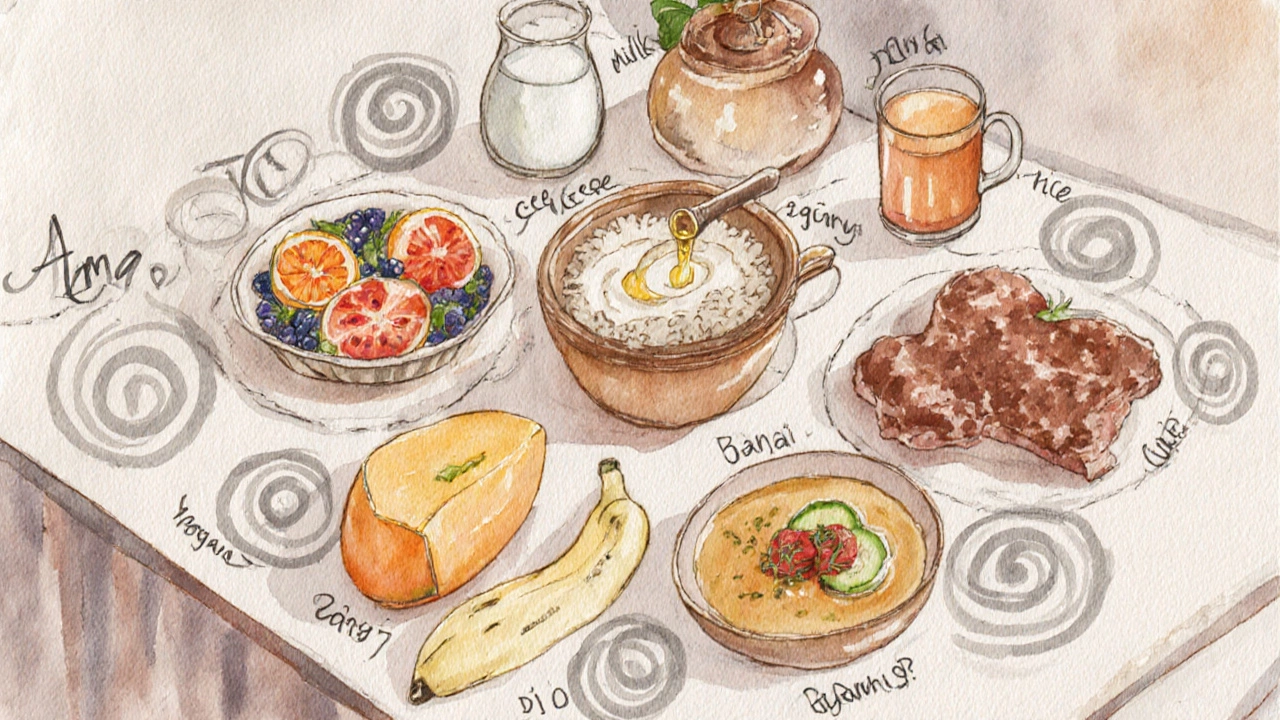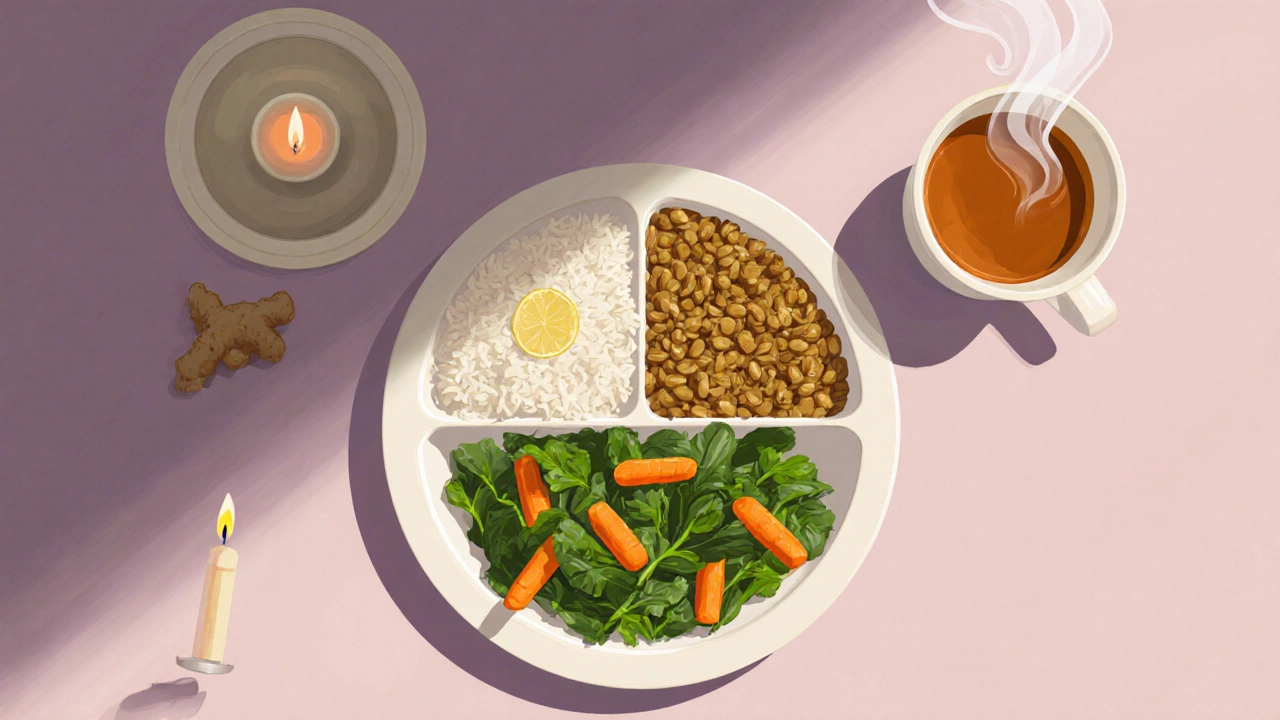
- Oct, 8 2025
- 0
Ayurvedic Food Combination Checker
Check Your Food Pairings
Select two foods from the dropdowns below to see if they follow Ayurvedic principles. This tool helps identify combinations that may weaken Agni and create Ama.
Ever wondered why you feel bloated after mixing certain foods? Ayurvedic food combinations offer a clear answer. In Ayurveda, the way foods interact can either support digestion or create hidden toxins that sap energy. This guide will walk you through the most common combos to steer clear of, why they matter, and practical tricks to keep your meals harmonious.
Why food combinations matter in Ayurveda
In Ayurveda is an ancient Indian system of health that balances body, mind, and spirit through diet, lifestyle, and herbal remedies, each bite carries a specific energetic quality. When two foods clash, they can disturb Agni is the digestive fire that transforms food into nutrition and energy. A weakened Agni produces Ama is undigested toxin that leads to heaviness, inflammation, and disease. By respecting the right pairings, you keep Agni strong and Ama at bay.
Core Ayurvedic principles behind food pairing
The three Dosha is the fundamental energies-Vata, Pitta, Kapha-that govern physiology and temperament provide the first check:
- Vata (air‑earth) thrives on warm, oily, grounding foods; it dislikes cold, dry combos.
- Pitta (fire‑water) needs cooling, slightly sweet foods; it’s upset by overly spicy or acidic pairings.
- Kapha (water‑earth) benefits from light, bitter, astringent foods; heavy, oily mixes increase congestion.
Beyond dosha, Ayurveda classifies foods by their intrinsic qualities (sweet, sour, bitter, salty, pungent, astringent) and by their digestion speed (light vs. heavy). Pairing a heavy protein with a fast‑digesting fruit, for example, creates a clash that slows Agni and breeds Ama.

Top 10 food combos to avoid
- Milk + Citrus - The acidity of oranges, lemons, or pineapple curdles milk proteins, causing mucus buildup and digestive distress.
- Milk + Fruit (except ripe mango) - Fresh fruits ferment quickly; mixing them with milk creates hard‑to‑digest curd that leads to bloating.
- Yogurt + Fruit - Similar to milk, the enzymes in yogurt clash with fruit sugars, producing excess gas and acidity.
- Honey + Heat (hot water, tea) - Honey is a natural sweetener that should never be heated above 40°C; high heat creates toxic compounds that tax the liver.
- Cheese + Fruit - Fermented dairy combined with raw fruit can impair digestion and increase Ama.
- Protein (meat, fish, beans) + Starch (potatoes, rice) in the same meal - Heavy proteins require longer digestion; starches digest quickly, causing fermentation when paired together.
- Banana + Milk - This classic combo is said to produce “clogged Alag” (lower digestive fire) leading to lethargy.
- Tomatoes + Cucumber - Both are high‑water vegetables but have opposite heating‑cooling properties, confusing Agni.
- Oil + Water‑rich foods (e.g., watery soups) in large amounts - Oil slows digestion while water speeds it up, creating a mismatch that leaves food half‑digested.
- Cold drinks with hot meals - Sudden temperature shift shocks Agni, reducing nutrient absorption.
How to pair foods the Ayurvedic way
Here are simple rules you can start applying today:
- Match similar digestion speeds. Light foods (fruits, leafy greens) should be eaten alone or with other light items.
- Combine complementary tastes. Sweet + bitter, or pungent + salty, balance each other and support Agni.
- Watch temperature. Warm meals with warm drinks keep the fire steady; avoid icy beverages right after a hot dish.
- Mind portion size. Large meals overload Agni; keep the plate about ¼ protein, ¼ starch, ½ vegetables.
- Allow proper gaps. Give a 30‑minute window between dairy and fruit or between heavy proteins and carbs.

Quick reference checklist
| Do Not Combine | Why It’s Problematic | Better Alternative |
|---|---|---|
| Milk + Citrus | Curdles protein, creates mucus | Enjoy citrus with water or herb tea |
| Milk + Fruit (except ripe mango) | Fermentation leads to Ama | Have fruit 2‑3hours after dairy |
| Yogurt + Fruit | Enzyme clash, gas | Eat yogurt plain or with cooked oats |
| Honey + Hot water | Creates toxic compounds | Stir honey into warm (≤40°C) tea |
| Protein + Starch together | Different digestion rates cause fermentation | Separate meals or keep protein light (e.g., lentil soup) with veggies |
Frequently asked questions
Can I ever mix dairy with fruit if I’m not lactose intolerant?
Yes, but only if the fruit is very ripe and sweet, such as mango or ripe banana, and you wait at least an hour after eating dairy. The ripeness reduces acidity, making the combo easier on Agni.
Is it okay to have a salad with cheese?
Cheese is a fermented dairy product, so pairing it with raw vegetables can create Ama for many people. If you love cheese, choose a aged, low‑fat variety and combine it with cooked greens instead of a raw salad.
What should I do if I accidentally ate a forbidden combo?
Sip warm ginger‑lemon water, avoid heavy meals for the next few hours, and take a short walk to stimulate digestion. Herbal teas like cumin‑fennel can also calm the stomach.
Do these rules apply to everyone, regardless of dosha?
The core principle-honoring Agni-holds for all doshas. However, Vata types may be more sensitive to cold, liquid combos, while Kapha individuals should watch heavy, oily pairings. Tailor the guidelines to your dominant dosha for best results.
Can modern food processing alter these Ayurvedic guidelines?
Processing can change a food’s energy (e.g., refined sugar becomes more heating). Always prefer whole, minimally processed ingredients, and re‑evaluate combos when you switch from raw to packaged versions.
Nikhil Verma
I'm a dedicated physician with a passion for exploring the intricacies of medicine, focusing on the unique healthcare challenges in India. I spend much of my spare time writing articles aimed at improving public understanding of health issues. Balancing my clinical practice and writing allows me to reach a wider audience, sharing insights and fostering a deeper appreciation for medical advancements. I derive immense satisfaction from both treating patients and engaging with readers through my writing.